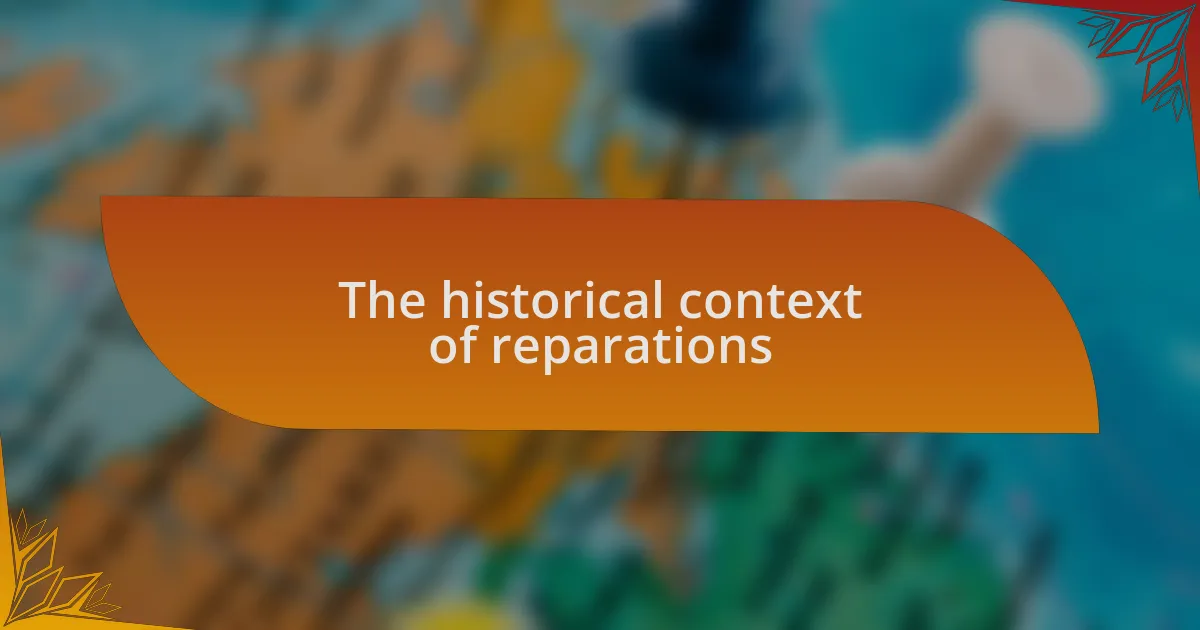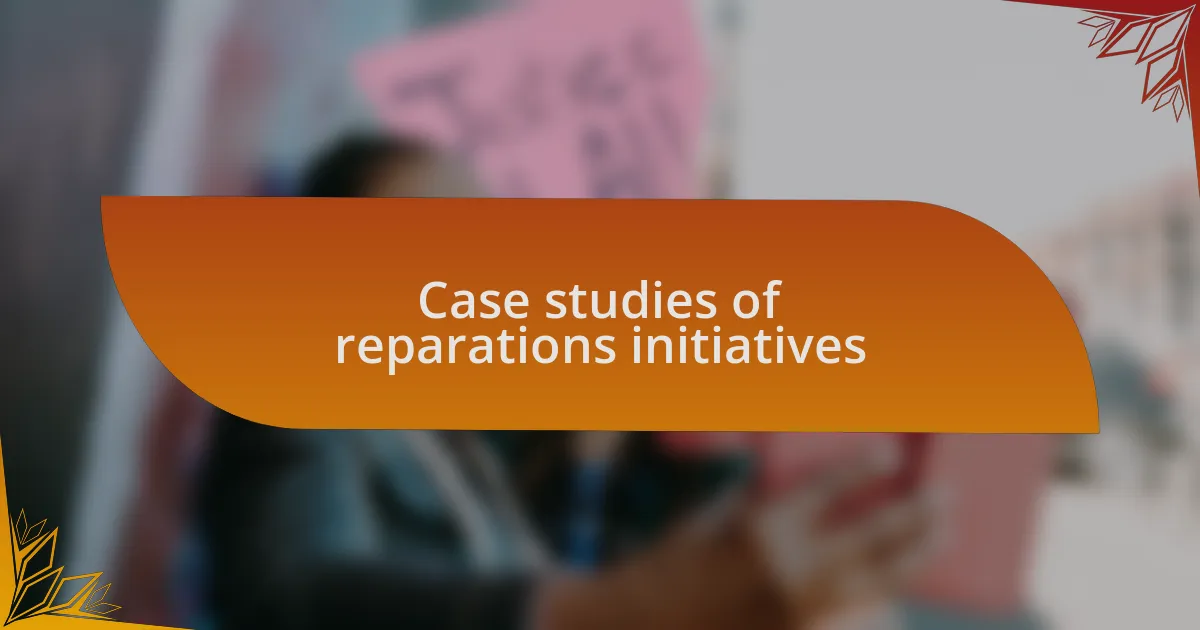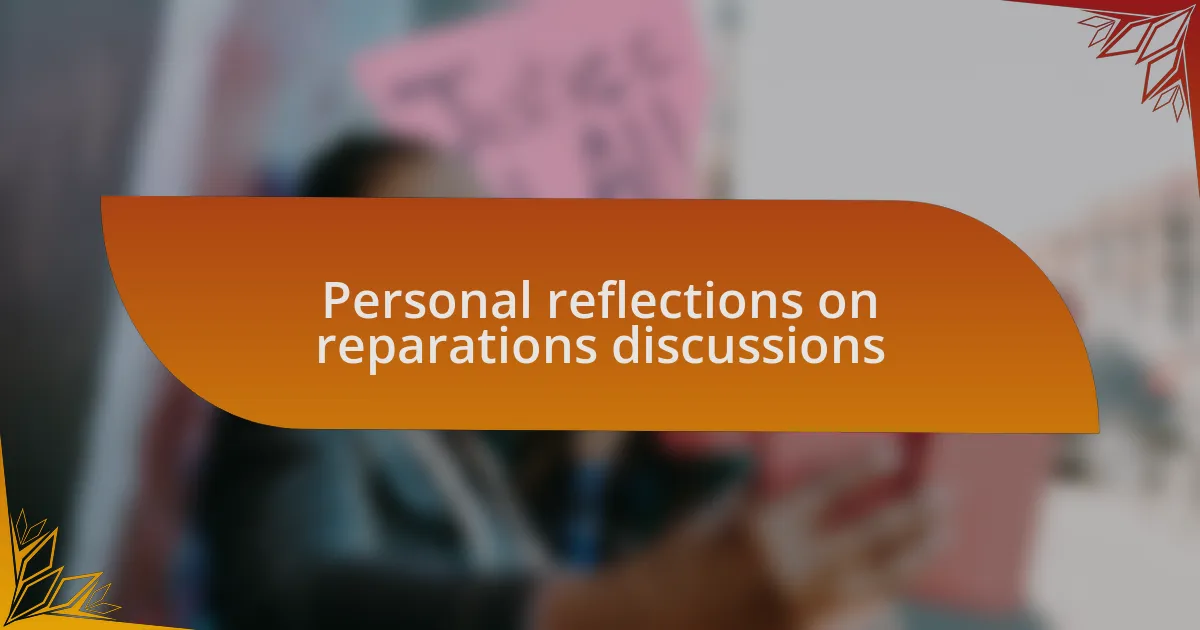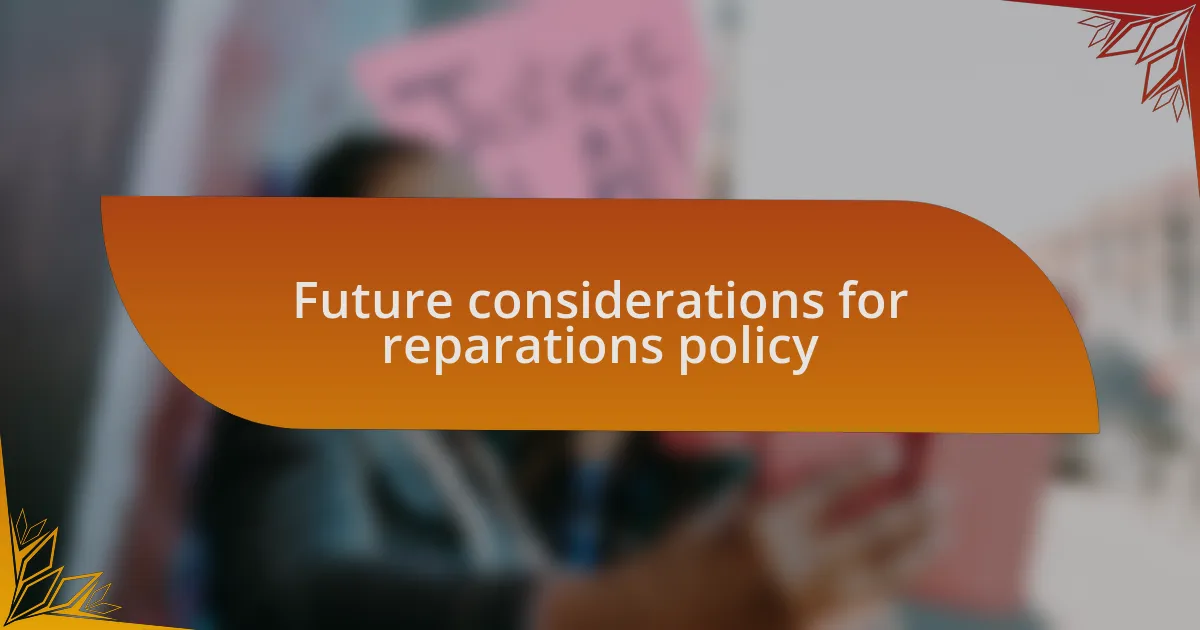Key takeaways:
- Reparations discourse encompasses both financial restitution and societal transformation, focusing on acknowledgment of historical injustices.
- Historical context reveals that unsettled agreements, such as “forty acres and a mule,” impact contemporary discussions on equity and justice.
- Successful reparations initiatives, like those in the U.S. for Japanese Americans and South Africa’s TRC, illustrate the importance of recognition and addressing collective trauma.
- Engaging in reparations discussions highlights the necessity for intersectionality, trust-building, and ongoing dialogue to foster healing and equity.

Understanding reparations politics
Reparations politics is a dynamic and often contentious field that stirs a wide range of emotions and opinions. I remember engaging in discussions where people expressed their deep-seated frustrations about historical injustices, questioning whether monetary compensation could ever truly account for the pain endured. It made me ponder: can we ever find closure, or is the discussion around reparations more about recognition and acknowledgment of past wrongs?
As I delved deeper into the topic, I realized that reparations politics is not just about financial restitution, but also about societal transformation. In conversations with activists, I learned how reparations can serve as a catalyst for broader conversations around racial equity and justice. It struck me that the heart of these discussions often revolves around the fundamental question: what does it mean for a society to heal from its past?
Listening to personal stories from individuals affected by systemic injustices really brought the abstract concept of reparations to life for me. I recall a powerful account from a community leader who spoke of her family’s lineage and their struggles. It was a vivid reminder that behind policies and debates, there are real people whose lives are shaped by historical inequality. Such insights have deepened my understanding and made me appreciate the complexity and necessity of approaching reparations politics with empathy and intentionality.

The historical context of reparations
The historical context of reparations stretches back to the aftermath of slavery, where the United States grappled with the moral and economic implications of its actions. I often found myself reflecting on the promise of “forty acres and a mule,” an idea that symbolized hope yet was never fully realized. How can we expect a nation to move forward when the foundational agreements from its past remain unfulfilled?
Post-Civil War America plunged into a confusing era of Reconstruction, where the aspirations for justice conflicted with widespread resistance. The tension between the government’s intentions and public sentiment makes me think about how history often repeats itself. It’s disheartening to realize that many of the same discussions about equity and redress we face today echo those from more than a century ago.
As I explored the impacts of colonialism and genocide against Indigenous populations, it struck me how reparations are interwoven into diverse narratives of loss and resilience. I remember speaking with a tribal elder who recounted the painful history of land dispossession, emphasizing the need for recognition and reparative justice. Can we truly heal as a society without acknowledging these multifaceted histories that shape our current landscape?

Case studies of reparations initiatives
One notable case study in reparations initiatives is the 1988 United States government apology and monetary compensation to Japanese Americans who were interned during World War II. Reflecting on this, I recall how powerful it was to witness a government finally acknowledge and rectify a historic injustice, albeit decades later. It made me wonder, could similar recognition foster healing in other marginalized communities?
In South Africa, the Truth and Reconciliation Commission (TRC) serves as a compelling example of how reparative justice can take shape in a post-apartheid context. I remember reading stories of individuals bravely sharing their experiences, which highlighted the intricate dance of justice and forgiveness. It raised a thought in me: can genuine progress come without facing the harsh realities of our collective past?
Another intriguing initiative occurred in Germany, where the government has provided reparations to Holocaust survivors. I find it thought-provoking that, even after so many years, this ongoing commitment to support and recognize victims shows a willingness to confront history. Still, it makes me ask whether financial compensation is ever enough to heal deep-seated trauma and loss.

Personal reflections on reparations discussions
Engaging in discussions about reparations often stirs profound emotions for me. I once participated in a community forum that addressed reparations for descendants of enslaved individuals. Listening to the personal stories shared, I felt a deep connection to the struggles and resilience of those affected. It made me reflect: how can we, as a society, move forward without recognizing this painful history?
I remember a conversation with a friend who challenged my views on what true reparations should look like. They argued that it’s not just about financial compensation but also about systemic changes in education and healthcare. This resonated with me; it sparked a realization that reparations must encompass a holistic approach for lasting impact. Are we ready to envision a future where equity is woven into the fundamental fabric of our systems?
One day, during an online panel about reparations, a speaker shared their family’s experience of loss due to historical injustices. They asked, “What does justice look like to you?” This question lingered with me long after the event. I found myself contemplating whether our definitions of justice could bridge the gaps created by past grievances. It reminded me of the necessity for ongoing dialogue — after all, reparations shouldn’t be a one-time conversation but rather an evolving discourse aimed at healing.

Lessons learned from reparations dialogues
Engaging in reparations dialogues has illuminated several key lessons for me. For instance, during a small group discussion, one participant shared how their grandfather had been denied opportunities purely based on his heritage. Hearing that story, I realized that these narratives are not just historical footnotes but living realities that continue to shape lives today. It made me wonder, how can we truly understand the depth of injustice without immersing ourselves in these individual accounts?
One striking insight I gleaned from these conversations is the importance of building trust among participants. I recall a moment when a skeptic in our group expressed frustration over the idea of reparations. Instead of dismissing their views, the group chose to listen actively, and this genuine dialogue transformed the atmosphere entirely. It taught me that addressing reparations requires patience and an openness to diverse perspectives.
Finally, these discussions highlighted the necessity of intersectionality in reparations dialogues. I had an eye-opening exchange with an activist who emphasized that issues like gender and class must also be considered. This resonated deeply with me, prompting some personal reflection on how various forms of discrimination interlink. It leads me to ask, can we ever reach true equity without understanding the broad spectrum of injustice experienced by marginalized communities?

Future considerations for reparations policy
Future considerations for reparations policy must carefully weigh the various forms of delivery. In one discussion, I listened to a speaker advocate for financial reparations, while another highlighted the importance of educational initiatives. This contrast made me appreciate that a one-size-fits-all solution might not be effective. How do we create a comprehensive approach that addresses both immediate needs and long-term systemic change?
Another point that’s often mentioned is the role of community involvement in shaping reparations strategies. I remember a vivid conversation where a participant described their community’s struggles and aspirations. Their passionate plea emphasized that those most affected should have a seat at the table when these policies are crafted. This consideration raises the question: how can we ensure that reparations are not only about compensating the past but also about empowering future generations?
Lastly, the emotional component of reparations is crucial in future discussions. I often think about how discussing my own family’s history of injustice left me grappling with feelings of anger and sorrow. It reinforced my belief that any reparations policy should not merely end with financial compensation but also incorporate healing processes for communities. After all, can true justice be achieved without also addressing the emotional wounds that persist?